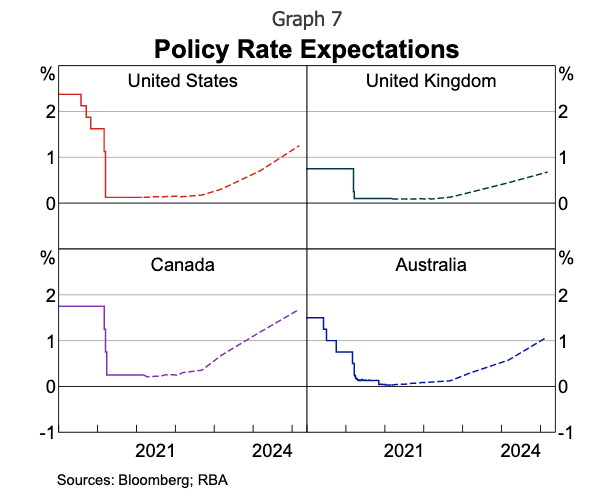Three trends creating tidal waves in markets

Livewire Markets
In Australia, and across the world, markets are being shaped by a number of new forces. There have clearly been significant shifts from the pandemic recovery, reflation and the vaccine rollout - as seen in the recent Australian earnings season.
But globally, advances in financial innovation, the upheaval of the bond market and interventions by the central banks have created not so much ripple effects as tidal waves throughout markets.
"The bond market is the largest listed asset class in the world," said Kate Howitt, portfolio manager of the Fidelity Australian Opportunities Fund. "Quite a bit larger than equity markets."
"When you get participants out there saying 'wow, rates are really going up and that means I'm going to lose money' ….maybe you want to take a little out of your bond allocation and put it into equities."
The bond market is at the end of a 40-year bull run, said Howitt at a recent Fidelity International briefing, but this is only one of three macro-level trends Fidelity is looking at.
1. "Bond refugees" to sustain markets for longer
"A bear market in bonds is any time you lose money," said Doyle.
One of the trends Fidelity has identified that will continue to sustain markets is the record flows from "bond market refugees".
Over the past month, Australian bonds have had their largest sell-off in over a decade, while the 10-year yields are now up to approximately 165 basis points over cash.
Anthony Doyle, the cross-asset investment specialist for Fidelity International, told us the carnage in the bond market has scared a lot of people off.
"Defensive assets still retain an important role in a multi-asset portfolio, but you're going to have to pay for that insurance. Particularly in real terms," said Doyle.
"The 30-year Australian Commonwealth government bond down 11% in a month has really frightened a lot of people," he said.
Against the backdrop of low-interest rates, bond markets have been struggling. And Fidelity believes what's coming out of bonds is tipping into equities.
And supposedly, this is exactly what central banks want to happen.
2. Central banks - saviour and risk enabler?
One of the more poignant discussions was around the role central banks are playing in markets today. Fidelity is seeing a movement from "lower for longer" to "higher for now" with regard to inflation - meaning that inflation will need to creep higher before the central banks will act.
We saw this in bond markets recently after February's "taper-less tantrum" when bond yields rose but central banks refused to pull the interest rate lever nor curb quantitative easing (QE).
"Their reaction function has changed... much like other central banks, whether it be the ECB, the Bank of England, or the Federal Reserve, they're far more focused on the labour market, driving down unemployment and generating higher wages in order to meet inflation targets," said Doyle.
The RBA is targeting 4.5% unemployment rate, while the current rate is at 6.4%.
In his speech at the AFR Business Summit, Governor Phillip Lowe said despite markets pricing in inflation, they will not raise the cash rate until an inflation target of 2-3% is met.
"It is not enough for inflation to be forecast to be in this range. Before we adjust the cash rate, we want to see actual inflation outcomes in the target range and be confident that they will stay there," said Lowe.
Sadly, markets are not rational beings. The RBA noted that "current market pricing suggests an expectation that some central banks will increase policy rates next year and in 2023."

Source: 'The Recovery, Investment and Monetary Policy', RBA.
But as monetary policy continues to maintain rates, investors are being pushed higher up the risk curve to get returns.
3. SPAC invaders: Financial innovation moves markets
Following on from a decade of ETFs and algo-driven trading, SPACs have arisen to unbelievable popularity.
According to Fidelity, so far in 2021 SPACs have raised $1 billion per day. SPACs (special purpose acquisition companies) are used as capital-raising tools for existing companies - you can read more on SPACs here.
A Bloomberg report has shown just how recent the rise of SPACs is; from just 59 companies raising US$13.6 billion in 2019, to 248 companies raising US$83.3 billion in 2020.
This activity in markets is converging with, or perhaps because of, a new category of investor Fidelity calls "pandemic punters". Cashed up investors with access to low-friction trading platforms and too much time on Reddit have increased the participation levels of retail investors to over 20% of the market turnover.
"Easier for money to come in, easier for money to trade, and that's always a late-cycle enabler and late-cycle sign. There are always new ways to put money into markets as you get to market tops," said Howitt.
Conclusion
These three trends are the lead indicators for Fidelity, particularly in the Australian market. While global trends have headwinds here, these alone aren't the sign of the market top.
"Predicting the market top or bottom is more about the flows and buyer exhaustion or seller exhaustion. So when will this market top out? Well, it's going to come from buyer exhaustion, not from fundamentals," said Howitt.
So, for Fidelity, a combination of macroeconomic trends (central banks and stimulus), investor behaviours, and financial innovation are going to be the biggest signals to "get out of the barn" as they say.
Not already a Livewire member?
Sign up today to get free access to investment ideas and strategies from Australia’s leading investors.
1 contributor mentioned

Mia Kwok is a former content editor at Livewire Markets. Mia has extensive experience in media and communications for business, financial services and policy. Mia has written for and edited several business and finance publications, such as...
Expertise

Mia Kwok is a former content editor at Livewire Markets. Mia has extensive experience in media and communications for business, financial services and policy. Mia has written for and edited several business and finance publications, such as...
